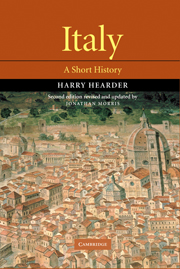Book contents
- Frontmatter
- Contents
- List of illustrations
- Preface
- 1 Italy in the classical world
- 2 The early Middle Ages
- 3 The high Middle Ages
- 4 The Renaissance
- 5 The political and cultural eclipse of Italy
- 6 The Risorgimento, 1790–1861
- 7 From Unification to Fascism, 1861–1922
- 8 The Fascist disaster, 1922–45
- 9 Italy since the Second World War, 1945–80
- Epilogue: From the First to the Second Republic: Italy 1980–2001
- A brief guide to further reading
- Index
3 - The high Middle Ages
Published online by Cambridge University Press: 05 February 2015
- Frontmatter
- Contents
- List of illustrations
- Preface
- 1 Italy in the classical world
- 2 The early Middle Ages
- 3 The high Middle Ages
- 4 The Renaissance
- 5 The political and cultural eclipse of Italy
- 6 The Risorgimento, 1790–1861
- 7 From Unification to Fascism, 1861–1922
- 8 The Fascist disaster, 1922–45
- 9 Italy since the Second World War, 1945–80
- Epilogue: From the First to the Second Republic: Italy 1980–2001
- A brief guide to further reading
- Index
Summary
Sicily under the Normans and Frederick II, 1130–1250
The Normans had come to Sicily as adventurers with few skills other than the military one. But by the time Roger II was crowned king of Sicily in 1130, they had shown themselves to be able administrators, and – what was perhaps more remarkable – they governed with considerable tolerance and flexibility. The kingdom included Calabria on the mainland, and Roger I (1031–1101) was able to draw on Byzantine experience in administration, through Greek officials. But the Normans constituted an undisputed, if small, ruling class. The Sicilian population they ruled was, of course, an extraordinary ethnic mixture, in which Greeks and Arabs predominated. From Norman charters it would seem that whereas the Normans brought their own laws for their Latin population, they allowed Greeks, Moslems and Jews to retain their own laws and to be judged by their own judges. The distinction between religious and secular law was, of course, an ill-defined one. Moslem countries have usually regarded the Koran as the basis of any legal system, and when the Normans referred to ‘Jewish Law’ they meant religious practices in the family and society. Greek and Arabic were used as official languages alongside Latin. Moslems were not violently persecuted by the government, but they were regarded as an inferior group, much as Christians had been under the Arabs, and both Moslems and Jews were discriminated against in tax policy.
- Type
- Chapter
- Information
- ItalyA Short History, pp. 66 - 95Publisher: Cambridge University PressPrint publication year: 2001



